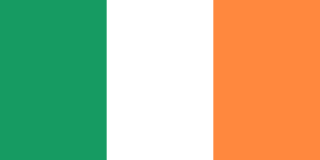Ireland - Geography

Here, let us take a look at the Geography of Ireland. Strategic location on major air and sea routes between North America and northern Europe; over 40% of the population resides within 100 km of Dublin. Mother's mean age at first birth is 30.9 years (2020 est.) (), whereas, the Maternal mortality ratio is 4 deaths/100,000 live births (2023 est.)
Geographical data of Ireland
| Location | Western Europe, occupying five-sixths of the island of Ireland in the North Atlantic Ocean, west of Great Britain |
|---|---|
| Geographic coordinates | 53 00 N, 8 00 W |
| Map references | Europe |
| Tarrain | mostly flat to rolling interior plain surrounded by rugged hills and low mountains; sea cliffs on west coast |
| Natural Resources | natural gas, peat, copper, lead, zinc, silver, barite, gypsum, limestone, dolomite |
| Natural Hazards | rare extreme weather events |
| Irrigated Land | 0 sq km (2022) |
| Major rivers (by length in km) | |
| Major aquifers | |
| Land Boundaries | 490 km |
| Border Countries | UK 499 km |
| Coastline | 1,448 km |
| Climate | temperate maritime; modified by North Atlantic Current; mild winters, cool summers; consistently humid; overcast about half the time |
| Area | |
| Total Area | |
| Land Area | 68,883 sq km |
| Water Area | 1,390 sq km |
| comparative Area | slightly larger than West Virginia |
| Maritime Claims | |
| Territorial sea | 12 nm |
| Exclusive fishing zone | 200 nm |
| Elevations | |
| Highest point | Carrauntoohil 1,041 m |
| Lowest point | Atlantic Ocean 0 m |
| Mean elevation | 118 m |
| Land Use | |
| Agricultural land | 63.1% (2022 est.) |
| Agricultural land: arable land | arable land: 6.5% (2022 est.) |
| Agricultural land: permanent crops | permanent crops: 0% (2022 est.) |
| Agricultural land: permanent pasture | permanent pasture: 56.6% (2022 est.) |
| Forest | 11.5% (2022 est.) |
| Other | 25.4% (2022 est.) |
Population Distribution
Population distribution is weighted to the eastern side of the island, with the largest concentration in and around Dublin; populations in the west are small due to mountainous land, poorer soil, and lack of transport routes
People and Society
In Ireland, the different Ethnic groups are such that we have: Irish 76.6%, Irish travelers 0.6%, other White 9.9%, Asian 3.3%, Black 1.5%, other (includes Arab, Roma, and persons of mixed backgrounds) 2%, unspecified 2.6% (2022 est.)
| Population | |
|---|---|
| Pop growth rate | 0.93% (2024 est.) |
| Birth rate | 11.1 births/1,000 population (2024 est.) |
| Death rate | 7.4 deaths/1,000 population (2024 est.) |
| Health expenditure | |
| Physicians Density | |
| Hospital bed Density | 2.9 beds/1,000 population (2020 est.) |
| Total fertility rate | 1.72 children born/woman (2024 est.) |
| Gross reproduction rate | 0.84 (2024 est.) |
| Contraceptive prevalence rate | |
| Est married women (ages 15-49) | 52.1% (2023 est.) |
| Literacy | |
| Education expenditures | |
| Net Migration rate | 5.6 migrant(s)/1,000 population (2024 est.) |
| Nationality | Irish | Irishman(men), Irishwoman(women), Irish (collective plural) |
| Languages | English (official, the language generally used), Irish (Gaelic or Gaeilge) (official, spoken by approximately 37.7% of the population) |
| Religions | Roman Catholic 69.2% (includes lapsed), Protestant 3.7% (Church of Ireland/England/Anglican/Episcopalian 2.5%, other Protestant 1.2%), Orthodox 2%, other Christian 0.9%, Muslim 1.6%, other 1.4%, agnostic/atheist 0.1%, none 14.5%, unspecified 6.7% (2022 est.) |
| Age Structure | |
| 0-14 years | 18.6% (male 498,124/female 477,848) |
| 15-64 years | 65.5% (male 1,701,680/female 1,728,041) |
| 65 years and over | 15.8% (2024 est.) (male 390,738/female 437,030) |
| Dependency Ratios | |
| Total dependency ratio | 52.6 (2024 est.) |
| Youth dependency ratio | 28.5 (2024 est.) |
| Elderly dependency ratio | 24.1 (2024 est.) |
| Potential support ratio | 4.1 (2024 est.) |
| Median Age | |
| Total | 40.2 years (2024 est.) |
| Male | 39.7 years |
| Female | 40.6 years |
| Urbanization | |
| Urban population | 64.5% of total population (2023) |
| Rate of urbanization | 1.15% annual rate of change (2020-25 est.) |
| Major urban areas (Pop) | 1.270 million DUBLIN (capital) (2023). |
| Sex Ratio | |
| At birth | 1.06 male(s)/female |
| 0-14 years | 1.04 male(s)/female |
| 15-64 years | 0.98 male(s)/female |
| 65 years and over | 0.89 male(s)/female |
| Total population | 0.98 male(s)/female (2024 est.) |
| Infant Motality | |
| Total | 3.3 deaths/1,000 live births (2024 est.) |
| Male | 3.2 deaths/1,000 live births |
| Female | 3.3 deaths/1,000 live births |
| Life Expectancy at birth | |
| Total population | 82 years (2024 est.) |
| Male | 80.3 years |
| Female | 83.9 years |
| Drinking Water Sources | |
| Improved: urban | urban: 95.4% of population (2022 est.) |
| Improved: rural | rural: 97% of population (2022 est.) |
| Improved: total | total: 96% of population (2022 est.) |
| Unimproved: urban | urban: 4.6% of population (2022 est.) |
| Unimproved: rural | rural: 3% of population (2022 est.) |
| Unimproved: total | total: 4% of population (2022 est.) |
| Sanitation facility acess | |
| Improved: urban | urban: 94.8% of population (2022 est.) |
| Improved: rural | rural: 98.2% of population (2022 est.) |
| Improved: total | total: 96.1% of population (2022 est.) |
| Unimproved: urban | urban: 5.2% of population (2022 est.) |
| Unimproved: rural | rural: 1.8% of population (2022 est.) |
| Unimproved: total | total: 3.9% of population (2022 est.) |
| Alcohol consumption per capita | |
| Total | 10.91 liters of pure alcohol (2019 est.) |
| Beer | 4.92 liters of pure alcohol (2019 est.) |
| Wine | 2.88 liters of pure alcohol (2019 est.) |
| Spirits | 2.29 liters of pure alcohol (2019 est.) |
| Other alcohols | 0.82 liters of pure alcohol (2019 est.) |
| Tobacco use | |
| Total | 16.8% (2025 est.) |
| Male | 19.2% (2025 est.) |
| Female | 14.4% (2025 est.) |
Demographic profile
All Important Facts about Ireland
Want to know more about Ireland? Check all different factbooks for Ireland below.









